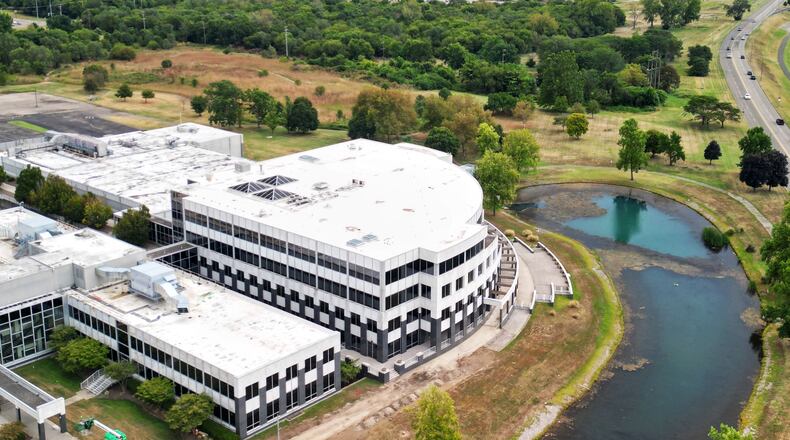“We’re going to work with other career technical schools throughout the state of Ohio, and we have a vision for bringing students to Hamilton to do the kind of work we’re talking about,” she said at the Oct. 1 State of the City Address at COhatch in downtown Hamilton.
A reason why housing is being explored in Hamilton is because of the Advanced Manufacturing and Workforce Hub, or AM Hub. Miami University acquired the former Vora Tech building on Knightsbridge, where it will open in early 2026 as an educational hub where Butler Tech and Miami students will study.
It’s a partnership with, among others, Miami University, Butler Tech, the city of Hamilton, Hamilton City Schools, OhioMeansJobs and 30 area businesses.
Credit: Nick Graham
Credit: Nick Graham
Earlier this year, the Butler County university system announced its regional campuses — Hamilton, Middletown and West Chester Twp. — will begin offering a polytechnic education as part of the educational package offered.
This education model is part of the university’s strategic plan, MiamiTHRIVE. The AM Hub is just the first step in a much-greater initiative at Miami University’s regional campuses.
Ande Durojaiye, Miami’s vice president for Strategy and Partnerships, said the applied learning at Miami’s polytechnic campuses will create a direct impact on students, the community and the economy where innovation in action will be on display daily.
“The polytechnic initiative aligns with Ohio’s most significant workforce needs, as identified through work with industry partners in southwest Ohio,” he said. “These partnerships strengthen the existing workforce pipeline by re-envisioning our curriculum to emphasize work-based applied learning, career coaching, and durable, essential skills that are highly valued by employers.”
A polytechnic education will incorporate all disciplines, he said, where Miami’s programs “will benefit from strong industry partnerships and experiential and work-based learning.”
Dan Bates of the Greater Hamilton Chamber of Commerce said he doesn’t think people will understand the “huge shift” Miami University is committing to at its regional campuses.
“It’s really known for its top-notch academia. Not that they’re walking away from that, but polytechnic changes the focus,” Bates said. “It’s really about career-readiness and targeting the academics to whatever path that person is taking.”
With the backing of Miami’s top brass supporting this shift, Bates said this may be the first time the regional campuses are “no longer just an appendage to Oxford but it has a focus and direction and funding.”
Credit: Nick Graham
Credit: Nick Graham
Ohio’s only polytechnic educational program, which is an educational model focusing on highly applied educational programs addressing needs of employers, will be at the Miami Regionals. This educational model initiative will blur the lines between the classroom and workforce, Casey said.
“We want to have industry experts working with our students in the classrooms and we want the students to be doing work-based learning at the employer’s site, so they know they’re getting the skills in those students that they want,” she said.
However, Miami’s polytechnic model is not just about students learning technical skills. Casey said they will be learning soft skills — communication, problem-solving, critical thinking, the ability to work in teams — so they students “are adaptable learners who can weather the changes in technology.” Employers, she said, have said that future employees need these skills.
Work that still needs to be addressed, as Miami is still two years out from launching its polytechnic learning model, includes a redesign of current programs to embed more applied learning and work-based learning; development of new academic programs from micro-credentials to associate and bachelor’s degrees; and expand and develop more partnerships.
A new campus master plan is needed since nearly 55 acres were added to Miami Hamilton’s campus, which is now nearly 150 acres, incorporating land south of Knightsbridge Drive to just north of Belle Avenue and between Neilan and University boulevards.
“These changes will create a direct impact on our students, our community and our economy,” Casey said. She added that when educational institutions like Butler Tech and Miami University partner to produce students who meet those workforce needs, “they will come to the community.”
University administrators are working with the Chicago-headquartered campus planning and architectural firm Perkins & Will to work on the campus master plan. This plan for Miami Hamilton would address things like the potential for student housing, but would “improve the campus gateways and edges,” connecting its southern and northern sections.
“It’s a very walkabout distance, but right now it doesn’t feel very walkable,” Casey said. “We’re looking at how we can re-strategize and do some physical facilities work on the campus to connect those two (sections).”
Credit: Nick Graham
Credit: Nick Graham
About the Author



